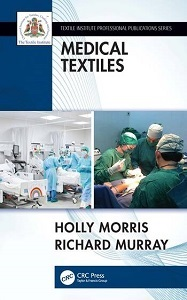Medical Textiles
Material type: TextLanguage: English Series: Textile Institute Professional Publications SeriesPublication details: Boca Raton, FL : CRC Press, c2022Edition: 1stDescription: XXII, 375 p. : illISBN:
TextLanguage: English Series: Textile Institute Professional Publications SeriesPublication details: Boca Raton, FL : CRC Press, c2022Edition: 1stDescription: XXII, 375 p. : illISBN: - 9780367772734
- 1st 610.28 MOR
| Item type | Current library | Shelving location | Call number | Copy number | Status | Date due | Barcode |
|---|---|---|---|---|---|---|---|
 Reference Collection
Reference Collection
|
Reference Section | Reference Section | 610.28 MOR | 2022-23 | Available | 98003 |
About Author
Ms Holly Morris holds dual professional registration across the medical and textile industries. Internationally trained, Holly is a registered medical professional currently completing higher surgical training in Trauma and Orthopedics with a subspeciality interest in Hand Surgery. She is a Fellow of the Royal College of Surgeons of Edinburgh. Holly's childhood love of textiles led her to gain a formal textile qualification through a Masters of Applied Science at the University of Otago, Dunedin, New Zealand. Her thesis centered around the role of textile technology in implantable bioscaffolds used within regenerative medicine and was co-supervised by Professor Raechel Laing and Associate Professor David Gwynne-Jones. Since her return to the United Kingdom to complete higher surgical training in Trauma and Orthopedics, near her family in the textile-infused East Midlands, she has continued to develop an interest in the field of medical textiles. As a Fellow of the Textile Institute, Holly already has several publications in professional literature including, most recently, a Review of the Medical Textiles sector which appears in the Textile Progress series. Her interests center the importance of upholding patient safety to the highest standards whilst welcoming innovation and technological progress, sustainability and the development of new devices. Holly is involved with a postgraduate Masters and PhD program in Medical Device Design and supervises postgraduate students. In addition, she is currently part of ENG4, a Not-For-Profit collaboration of professionals and volunteers designing and developing garments for the COVID-19 pandemic. The group was awarded the 2021 Institution of Engineering Designers' Gerald Frewer Memorial Trophy. Holly enjoys mentoring juniors within the medical profession and has a healthy regard for fellow nonconformists. Professor Richard Murray was Pro-Vice Chancellor International and Dean of the Hollings Faculty at the Manchester Metropolitan University (MMU) in the United Kingdom for 15 years before becoming Emeritus Professor in 2011. Richard graduated in Textile Chemistry from the University of Leeds and, combining protein chemistry with electron microscopy, carried out research into wool fiber fine structure for his PhD before continuing his research in textile physics, publishing papers on wool, cotton, polyester, Kevlar 49 and carbon fiber fine structures before moving to Edinburgh to pursue a lecturing career and to develop research into fabric care and high-performance garment design. During that time, Queen Margaret College where he worked had the widest range of healthcare courses in the UK, and one of Richard's duties was to guide them in the development of their Diploma courses into Bachelor's Degree programmes, hence his continuing interest in textiles and health , and his research into aspects of clothing comfort and function. During his time in Edinburgh, Richard was the member for Scotland on the Consumer Standards Advisory Committee of the British Standards Institution, he represented the Scottish University sector on the General Teaching Council for Scotland, was Chairman of the Scottish Section of the Textile Institute, and worked as Technical Director for two small companies in England. At MMU one of Professor Murray's priorities was to establish new partnerships with leading universities in China, particularly with those undertaking teaching and research on textiles and garment design & technology. He became a Visiting Professor at several Chinese universities including Donghua, Huizhou and GDUT, delivering lectures and presentations to university staff, students and to business representatives on a regular basis. Richard is the Chairman of the Textile Institute Publications Committee and the Editor of its research review journal, Textile Progress and he maintains his research interests as a member of Professor Kuo-bing Cheng's textile research team, 'GLORIA' at Feng Chia University in Taiwan. At MMU one of Professor Murray's priorities was to establish
Summary
This textbook aims to ensure that advances in medical textiles are addressed and that recent developments are able to be appreciated and understood not only by medical practitioners and healthcare personnel but also by textile scientists and technologists. The idea is to stimulate collaborative research and development in the field of medical textiles and to equip researchers with an understanding of the steps they need to take to ensure that their efforts, be they to develop new devices for implantation or items for external application, are carried out in such a way as to improve their effectiveness and enhance the prospects for their implementation. Attention is drawn to the need to improve outcomes in the practical setting and to guidance on the detailed planning required prior to engaging in experimental work. Standard tests can help researchers to monitor performance, but for some important applications such as those required to demonstrate antimicrobial and fluid-repellent performance in most items of protective wear, standard tests consistently fall seriously short in terms of predicting how well they might work in the practical setting. Guidance is therefore given for their further development.
